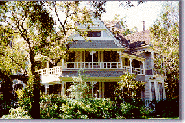General-
 Historians have concluded that the
man this city is named after, the Baron de
Bastrop, was a
fraud. His real name was Philip Hendrick Nering Bogel,
and he was formerly a tax collector in Holland who had
fled that country when charged with embezzlement. Even
though he was a fraud, however, his place of honor in
Texas history is genuine. Using his cloak of fictitious
royalty, he was serving as the second alcalde of San
Antonio when Moses and Stephen F. Austin made their
second attempt to obtain permission to set up a colony in
Texas. The "Baron" is credited with convincing
the Mexican government to give the Austins the colony
grant. It is conceivable that without his intercession
they would have been turned down again. Historians have concluded that the
man this city is named after, the Baron de
Bastrop, was a
fraud. His real name was Philip Hendrick Nering Bogel,
and he was formerly a tax collector in Holland who had
fled that country when charged with embezzlement. Even
though he was a fraud, however, his place of honor in
Texas history is genuine. Using his cloak of fictitious
royalty, he was serving as the second alcalde of San
Antonio when Moses and Stephen F. Austin made their
second attempt to obtain permission to set up a colony in
Texas. The "Baron" is credited with convincing
the Mexican government to give the Austins the colony
grant. It is conceivable that without his intercession
they would have been turned down again.
The town was established on the
site of an old Spanish post that guarded the place where
El Camino Real (The King's Highway) crossed the Colorado
River en route to East Texas. Naturally, Stephen F.
Austin named the new colony Bastrop after its benefactor.
But in 1834, the newly independent Mexican government
renamed the town Mina after a Revolutionary hero. Then
came the Texas Revolution. Three Bastropians were among
the signers of the Texas Declaration of Independence, 11
died in the Alamo, and around 60 were recorded as having
fought at the decisive Battle of San Jacinto. In 1837,
after the revolution, the name was changed back to
Bastrop and given to both the town and the new county.
Bastrop is the site of what are known as the "Lost
Pines of Texas". This is a large (70 square miles) but
isolated forest of Southern pine trees located 80 miles
west of the main pine belt. In the nineteenth century
these loblolly pines supported the local lumber industry.
The first edition of The Bastrop
Advertiser and County News was published on March 1,1853,
giving it claim to being the oldest continuously
published weekly in the state. At one time Bastrop also
had the oldest drug store in the state. That burned down,
but still around, although not quite so old, is Lock's
Drug Store on Main Street, with a turn-of-the-century
interior and an old-time soda fountain. In 1979, the
National Register of Historic Places admitted 131 Bastrop
buildings and sites to its listings. Thirty one buildings display
a Texas Medallion marker. Main
Street is lined with with century old
structures housing antique shops, restaurants, and specialty stores. Main
Street and Fisherman's Park follow
the scenic Colorado River for great places
to picnic, fish, and canoe. The old historic Iron
Bridge crossing the river has been converted to a park with
picnic tables, benches, and walkways above the Colorado
River.
Bed and Breakfast accommodations
are offered in many historic buildings. Also, for more information on
Bastrop and Bastrop County, visit the LCRA's Colorado River Trail Bastrop County.
Bastrop Chamber of Commerce
Bastrop Historical Museum
702 Main
(512)303-0057
Mon - Fri 1 pm to 5 pm, Sat 10 am to 5 pm, Sun 2pm to 5 pm
The original little red house was
built in 1850; the brick wings were added by the Bastrop
County Historical Society in the 1970s to provide exhibit
space. Some of the furniture, clothing, dolls, books, and
records on display date back to the time when Bastrop was
deeply involved in the struggle for Texas
Independence.
Bastrop County Courthouse and
Old Jail
Pine and Water
The three-story courthouse was
built in 1884 and is still in use. The Old Jail next
door, built in 1892, had jailers quarters on the first
floor and cells on the upper two floors. It was used as a
jail until 1974 and is now used for county offices.
Governor Joseph Sayers Home
1703 Wilson
Joseph Draper Sayers was the last
Confederate soldier to become governor of Texas, serving
from I899 to 1903. This Greek Revival home was built in
1868 soon after Sayers returned to Bastrop from the Civil
War. It is a private residence, not open to the public.
Bastrop State Park
TX Hwy. 21 about I mile east
(512)321-2101
Open seven days 8-5 (to 7 in summer) for day use, at all
times for camping
$2 per vehicle per day
Located among the "Lost Pines
of Texas", ' this 3,500-acre park has a
swimming pool
(summer only-fee), golf course, a 10-acre
lake, hiking trails, picnic
tables, tent and RV campsites (fee), and
13 cabins (fee), which may be booked 90 days in advance.
Park Rd. 1 connects with Buescher State
Park, about 12
miles east.
Lake Bastrop
This 906-acre lake is primarily a
cooling pond for the Lower Colorado River
Authority's Sim
Gideon Power Plant. However, it also offers recreational
facilities in two parks for boating (fee),
fishing, swimming,
water-skiing, picnicking, and
camping (fee).
The parks on this lake are not state parks but LCRA
Parks.
South Shore Park: From Austin take Hwy 71 east to Bastrop, take a left onto Hwy 95. Go approximately .5 mile. Take a right onto Hwy 21 East. Go approximately 2 miles and turn left onto South Shore Road (also CR 352). South Shore is on the right.
North Shore Park:
From Austin take Highway 71 east to Bastrop. Take Highway 95 north and turn right on FM 1441, drive 2.5 miles to the park entrance and turn right.
Visitor
Center
For information about events, attractions,
or places to dine, stop by the Chamber
of Commerce office. There are also brochures for self
guided walking and driving tours.
|


